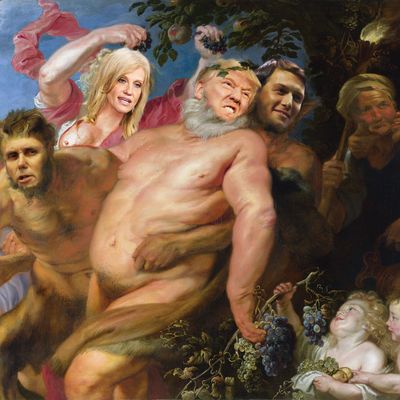
Johnny Carson opposed the Vietnam War. In his private life, he was something of a social liberal as well as a civil-rights advocate who had Harry Belafonte and Martin Luther King Jr. on The Tonight Show just two months before King’s assassination. If you watched over decades, you could, faintly, discern Carson’s politics by his choice of guests, or by the way he leaned into some interviews but could barely bother to make eye contact during others. In 1970, a year before Roe v. Wade went to the Supreme Court, he was drawing 10 million viewers a night and told Life magazine, “In my living room I would argue for liberalization of abortion laws … there are times when I would like to express a view on the air … But I’m on TV five nights a week; I’ve nothing to gain by it and everything to lose.”
By the time Carson died in 2005, the three-network universe of his heyday had given way to the niche multiverse. Jon Stewart was deep into his Daily Show run, and the detached, wry, politically nonspecific View From Nowhere that Carson had embodied was rapidly eroding. What little of it remained was incinerated this past November by the permanent state of emergency that many people in the crowded late-night field (not to mention their viewers) seemed to shift into after the election. For them, the ascendancy of Donald Trump has posed a double challenge: How political are they going to be, and how oppositional are they going to be?
Building your comedy around the premise that Trump is a grave danger to all of us is probably not going to offer a laugh a minute, but on the other hand turning him into a buffoon — hitting only the tortured coiffure, the orange war paint, and the oblivious self-aggrandizement — can be a way of making him seem like less of a threat than he is, an approach that’s been the subject of dispute since Charlie Chaplin did it in The Great Dictator. Late night’s various takes on Trump mostly seek a midpoint between apocalyptic and shrug emoji, but the hosts can also be charted along a different spectrum: How comfortable are they with politics in the first place? When they (or their writers) read the news, are they sifting it for information, outrage, or just joke potential? And how much of who these people are in their own living rooms can they afford to be when they come into ours?
Watch a supercut of late night TV’s best political jokes:
Late-night TV is, more than any other part of the medium, an implied conversation: Comedians talk to us, and a live audience gives them real-time feedback. Right now, the main subject — really the only subject — is Trump. As a target, he has always been both irresistible (because he’s hypersensitive to critique) and frustrating (because he’s unaltered by it). That’s underscored now that his presidency has redrawn the power map in late-night comedy.
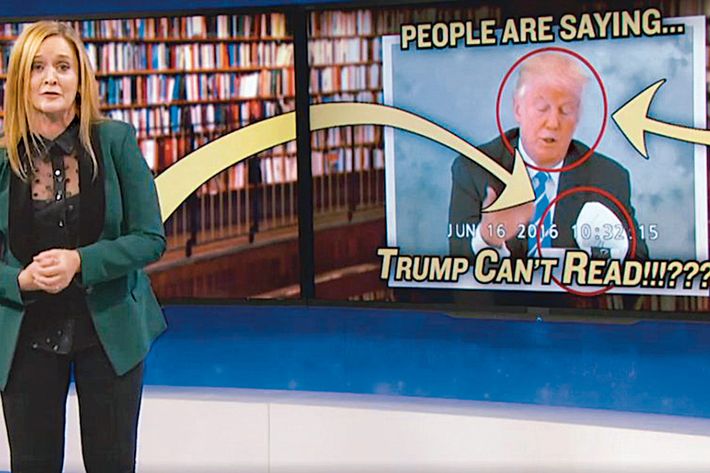
The biggest beneficiaries are, no question, the Splenetics: Daily Show vets John Oliver and Samantha Bee. Bee, whose remarkable TBS half-hour Full Frontal is just starting its second year, forged her show in the crucible of an election whose gender hypocrisies especially enraged her. She is searingly, intoxicatingly livid in a way that might be wearying on a nightly basis but is a bracing cold slap once a week. Fearless in her contempt for the kind of old-boy networks to which the very existence of her show is a rebuke, she is literally willing to take it to the streets, whether in Washington, D.C., for the Women’s March or on road trips to last year’s conventions. Leave it to others to be bemused or concerned by the man she has called, among other things, a “crotch-fondling slab of rancid meatloaf”: She and her small, diverse, mostly female set of correspondents are pissed. As is Oliver, whose ability to toggle between hilariously profane spluttering and sustained, lucid investigation of an infuriating injustice makes him into the kind of seethingly adversarial journalist that adversarial journalists who are permitted to seethe only inwardly sometimes wish they were — and that they believe they could be if they just had 20 more minutes to tell a story and 20 fewer constraints preventing them from doing it.
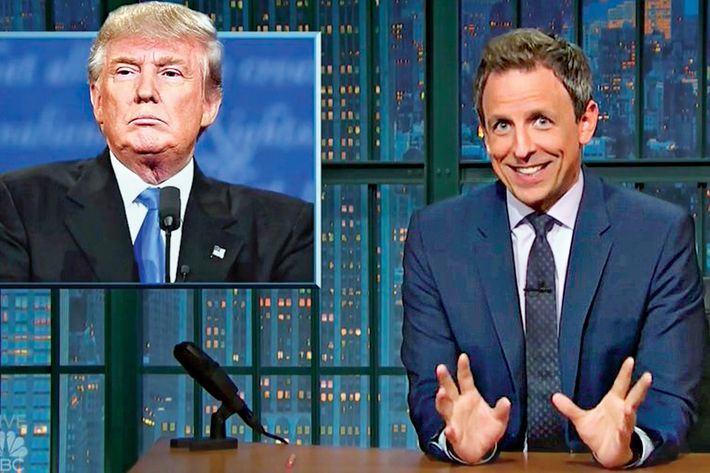
If Clinton had won, Bee and Oliver would both have been just fine, speaking truth to power while heaping scorn on her obstructers. But these two were built for more difficult times; embattlement becomes them. Their vibe isn’t “This too shall pass”; it’s #resist (although neither one is above a good hashtag joke). And their status as immigrants (Bee, born in Canada, is an American citizen; Oliver, who is married to a U.S. Army veteran, is not) lends extra sting to their perspective; when they say “we” or “us,” it means something. You know where they’re coming from.
Because their shows air weekly, Bee and Oliver have the luxury of prep time. But for the nightly hosts, the job is to process the day for people, synthesizing everything that happened into another chapter of an ongoing narrative, a rage aria, or a riff. If Trump demands a stepping-up of one’s game, Seth Meyers has demonstrated that this was the chance he was waiting for. When he segued from Saturday Night Live’s “Weekend Update” to his own show in 2014, Meyers seemed prepared to become an affable, better-read version of your basic late-night host: an opening monologue followed by a desk bit and interviews. But the long campaign either coincided with a personalizing and sharpening of his style or helped spark it. Meyers is the right guy at the right time: You can tell he’s an avid, all-day consumer of news, and his distaste for Trump feels gratifyingly specific. He may not be the policy wonk that Oliver is, but he’s got a good range of distress: He’s genuinely angered by bullying, sees through bluffing and bravado, and is merciless about double-talk and dishonesty. That’s a useful set of triggers to have in the Trump era, and whether dueling Kellyanne Conway to a draw or choking up the night after the election when talking about his mother and his baby son, Meyers has found real focus; his droll, disgusted “A Closer Look” segments, often prereleased to the internet, are funny, precise, and self-defining.
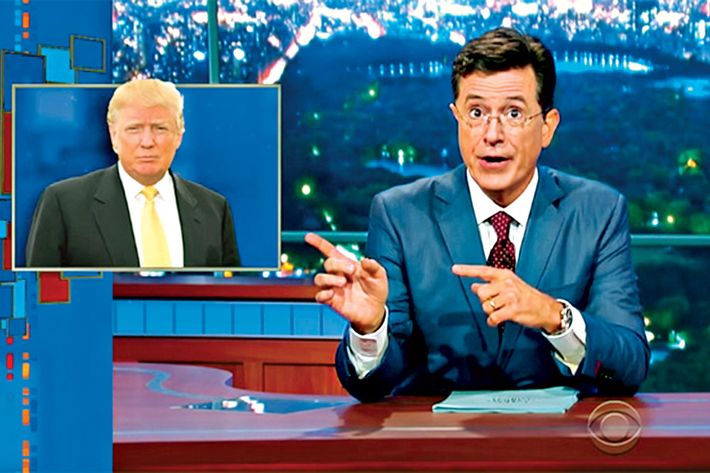
Likewise, Stephen Colbert, whose 2006 White House Correspondents’ Dinner keynote remains the single most savage and daring piece of political stand-up in the past dozen years, seems to have rediscovered his voice since the election, after shelving it in his jump from The Colbert Report to David Letterman’s old slot on CBS. Colbert may never find a vehicle for political comedy as bespoke as his alter ego “Stephen Colbert.” When he speaks as himself, his strengths are neither outrage nor heart-on-sleeve sincerity. But as even-keeled and reasonable as he is, when he wants to, he can come at you hard, and there’s something legitimately subversive about doing so on stately old CBS. When he talks about the transgender-bathroom issue and, after showing a clip of Sean Spicer, snaps, “Oh, grow a pair — is there any more cowardly phrase than ‘This is a states’-rights issue?,’ ” the White House is not getting mocked by the class clown. It’s getting told off by the school principal.
It’s no surprise that a reenergized Colbert is suddenly edging Jimmy Fallon in the ratings. The happy-all-the-time Tonight Show host clearly wants to be the heir to Carson’s “What I think doesn’t matter” ethos, but as his catastrophic Trump interview in September proved, there’s a difference between neutrality and servility. What hurt Fallon so much — the reason that too-close encounter has stuck to him like tar and feathers — isn’t that he ruffled Trump’s hair; it’s that he thought it would play well.
Fallon has become a paradox: He’s polarizingly apolitical. To him, a talk show is still Fun Central, a safe-space bubble in which you check your opinions at the door. (He recently had Susan Sarandon on — they talked about her new show, then they played a game of musical chairs involving cups of beer. It’s like that. It’s never not like that.) The problem is, willfully forgoing a point of view isn’t fun these days. Even James Corden, whose show rivals Fallon’s for manic cheerfulness, doesn’t tiptoe around politics, partly because Corden, for all his karaoke jubilance, doesn’t feel nervous about throwing a punch the way Fallon does. Fallon still relishes his job; nobody looks happier to come through the curtain (he loves being a talk-show host the way Brian Williams loves being a newscaster). Lately, he’s rolled out an undangerous Trump impersonation (he blusters and repeats things and has tiny hands and … that’s it) and infused his monologues with more politics. But his Trump jokes are just that: unconnected jests that evaporate before you hear the rim shot. You can practically feel them on the cue cards and count them down as Fallon reels them off, but they don’t build to anything or tell a story. It’s not comedy of the moment so much as comedy of no moment.
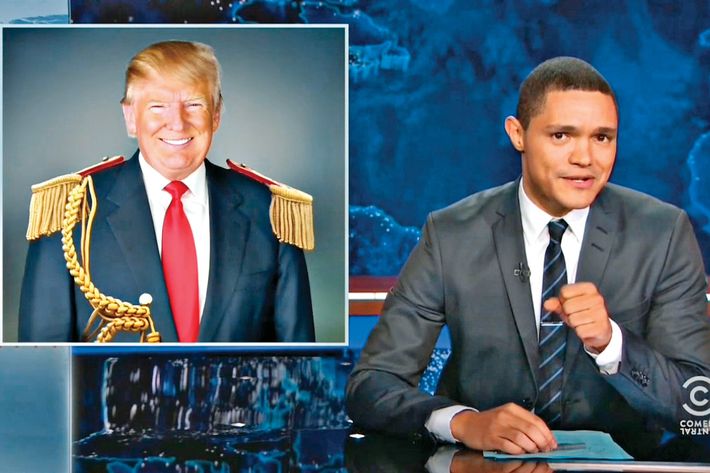
Spoofing the unspoofable is impossible: What to do in a world where “The travel ban is not a ban which makes it not a ban” is written for a sketch, and “The news is fake because so much of the news is fake” is spoken by a president? Not everyone is finding his way. The Daily Show’s Trevor Noah often seems to be hunting for a contrarian perspective that doesn’t owe allegiance to the left or right. As an immigrant and a person of color, he could theoretically seize this chance. But it’s never easy for a member of a minority who craves mainstream appeal to own his anger publicly (ask Obama how that worked), and when discussing Trump, Noah often falls back on generic “Can you believe this guy?” scorn (as did Obama; ask him how that worked). And Jimmy Kimmel and Conan O’Brien, while not locked out of Trump-era comedy, don’t seem to have an immense appetite for it. The Oscar-night potshots Kimmel aimed at Trump weren’t nearly as heartfelt (or numerous) as the ones he aimed at Matt Damon; it’s not shocking that he has told Variety he’s mulling retirement or that TBS is considering taking Conan down to once a week. Give these veterans a subject about which they can remain aloof and they’re matchless, but neither Kimmel’s L.A. guy’s-guy vibe or O’Brien’s Harvard Lampoon/Simpsons absurdism is a perfect fit for tackling this president.
The current colossus is, of course, Saturday Night Live. In its 42nd season, it’s an event again, even more so than in 2008, when Tina Fey’s Sarah Palin became a major news happening. It’s the only one of these shows Trump watches, which is both empowering and queasy-making. More than most, Lorne Michaels understands Trump as, among other things, a product of NBC, and, as if in ongoing apology for having let him host in November 2015, the show has decided to go after him, with ratings that recently topped those for any prime-time network series.
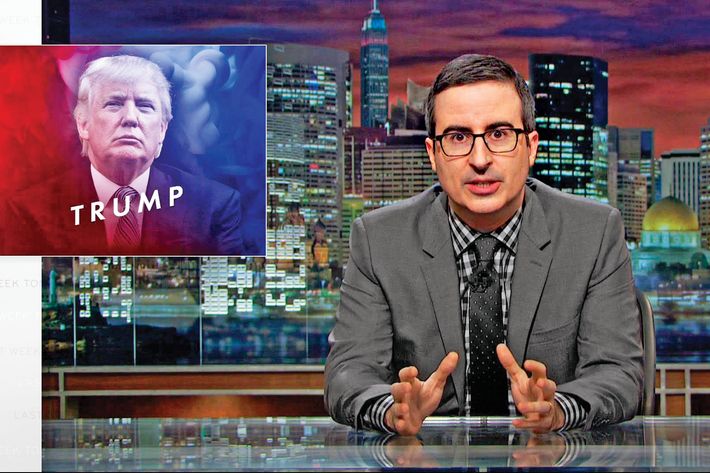
But go after him how? SNL’s specialty has always been takedown by impersonation rather than by especially incisive political commentary. That’s why it went through many different Trumps before enlisting Alec Baldwin; casting is often the most powerful — and last — creative decision the show makes. Occasionally, performance and writing will merge so triumphantly, as they did with Melissa McCarthy’s unannounced first appearance as Sean Spicer, that the viral result becomes front-page news. But often, coming up with one joke about someone (say, Steve Bannon as the Grim Reaper) makes it impossible for SNL to make any others. And misfires like the Kellyanne Conway Fatal Attraction sketch are a reminder of just how old-school SNL can be. The show road-tested a convictionless version of Conway last October as a loyal spokesperson at the mercy of a loony boss, then pivoted, rendering her as a sexualized psycho whose lifeblood is the camera lens. The result was not a cheap shot so much as a terribly aimed one, a default let’s-make-her-a-whore perspective that suggested a writers’ room overmatched by the pace of events. Right now, SNL feels burdened by the knowledge of how badly its audience wants it to draw blood. Samantha Bee and John Oliver always know why they hate someone; sometimes, SNL just knows that it hates someone. That’s not enough. Saying that nobody can afford to miss may be a burdensome constraint under which to place people who make their living being funny. But nobody ever said comedy was fair.
*This article appears in the March 6, 2017, issue of New York Magazine.
Top image: Artwork by Cecily Brown. Commissioned for Daily Trumpet/Instagram, in collaboration with Alex Gibson. Source photographs: Mandel Ngan/AFP/Getty Images (Kushner head); Michael Conroy/AP Photo (Pence head); Carlo Allegri/Reuters (Bannon head); Chris Goodney/Bloomberg via Getty Images (Conway head); Dominick Reuter/Reuters (Trump head). Painting: Anthony van Dyck, “Drunken Silenus supported by Satyrs,” c. 1620.

